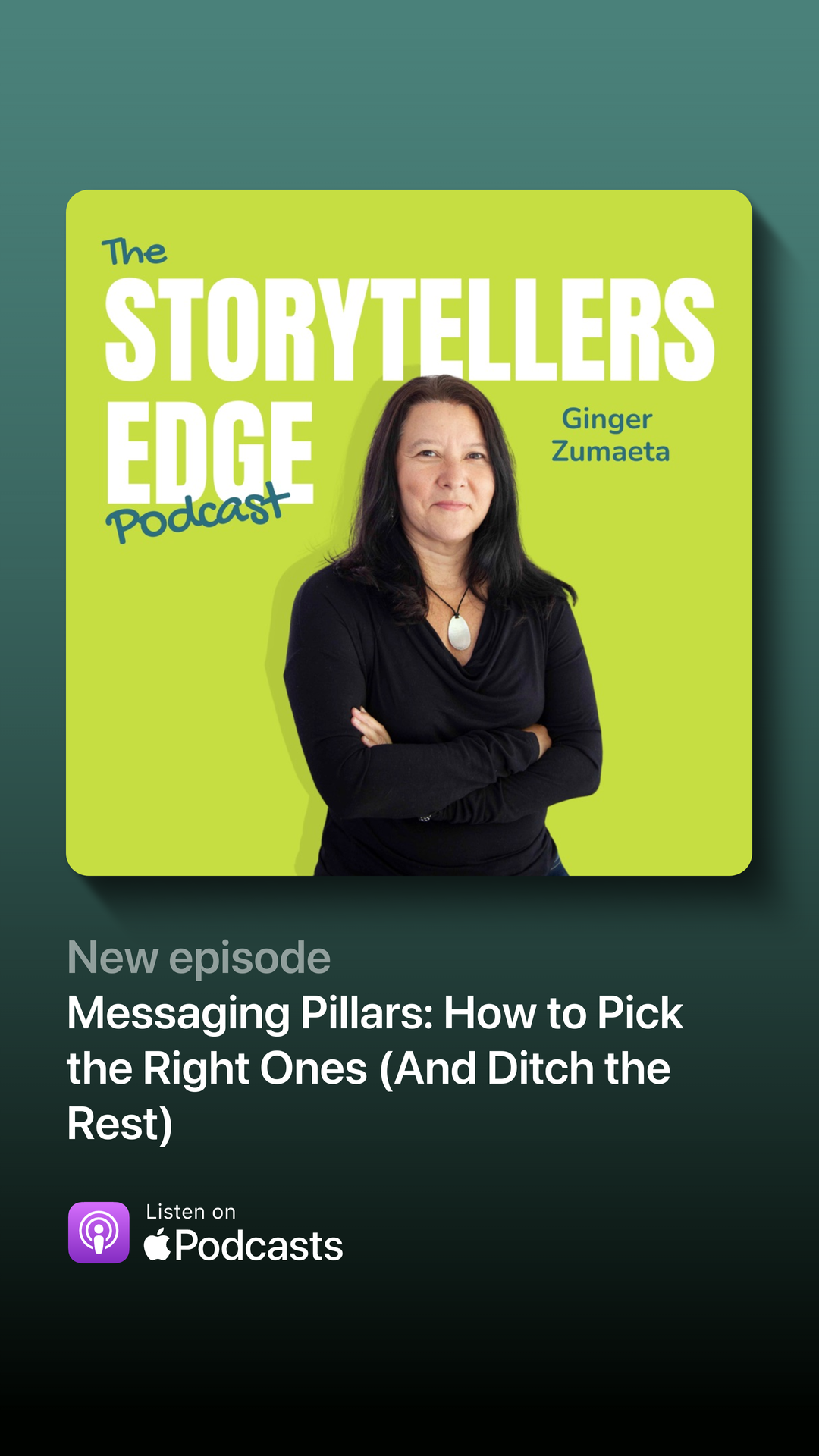Messaging Pillars: How to Pick the Right Ones (And Ditch the Rest)
%20(26).jpg)
You thought your message was clear—until you had to actually write it.
It made sense in the meeting.
It sounded good at happy hour.
But now you’re mid-deck, mid-launch, mid-doc—and nothing’s clicking.
Your go-to lines suddenly feel like corporate mush. You’re rewriting the same sentence 47 times. And every version sounds just a little… off.
Welcome to the silent messaging spiral.
In this episode of The Storyteller’s Edge, Ginger Zumaeta (3x Emmy winner, author of Deckonomics, and messaging strategist to the world’s sharpest teams) unpacks one of the most costly and overlooked problems in business communication:
👉 The absence of clear messaging pillars.
Here’s what you’ll learn:
1. What Messaging Pillars Are (and Aren’t)
They’re not values.
They’re not vibes.
They’re not platitudes.
And they’re not just themes.
Messaging Pillars are the strategic talking points that everything you say ladders back to, and they should show up everywhere—sales, marketing, fundraising, internal comms.
From a functional perspective . . . Messaging pillars support your positioning by defining how you communicate your unique value in a way that matters to your audience—and relative to other choices they have.
They help you anchor your story to what your audience cares about most, making it clear why you—not the next best alternative—are the right choice.
But functionally . . .
They serve as guardrails, ensuring your content and communications stay consistent, aligned, and clear across teams and channels.
They make scaling your messaging easier as you grow, reducing drift and wasted effort.
Bottom line: Messaging pillars turn your positioning into practical, audience-relevant messages that compete effectively in the real world.
They should derive from your positioning (which is a whole other topic) but basically it’s your position in the minds of your audience whether it’s buyers, funders, or whatever.
2. How to Spot a Weak Pillar
Here’s your red flag checklist:
☒ Too broad to mean anything - ex. Convenient, superior, etc.
☒ Sounds like a corporate value in disguise - creating a better world . . .
☒ Overlaps with the other ones - there’s a term MECE *mutually exclusive collectively exhaustive
☒ Never actually shows up in conversation
If your pillars don’t make you (or the people who communicate on behalf of your org) sound sharper in a meeting, they’re not helping.
3. How to Build One That Sticks
Step 1: Limit yourself to 3–5. More than that? Word salad.
Step 2: Give each one a POV. Say something. Don’t just agree with the industry. Take a stand. Challenge assumptions. Reframe the problem.
Step 3: Stress test it. Would your team actually use this in a pitch?
Step 4: Make it unmistakably yours. If a competitor could say it, scrap it.
Example:
Let’s say you’re a healthtech startup that helps clinics reduce patient no-shows through smart scheduling and text reminders.
Here’s the kind of vague, unhelpful pillar I often see:
❌ “Patient Engagement”
(Sounds important. Means nothing. Zero direction for content or messaging.)
Now here’s a stronger, sharper messaging pillar:
✅ No-Shows are a Communication Problem, Not a Patient Problem
We help clinics cut down no-shows by building clear, automated outreach flows that make it easy for patients to confirm—without staff chasing every appointment.
Why it works:
- Clear audience: Clinics and busy healthcare providers
- Strong POV: No-shows aren’t a patient problem—they’re a communication problem
- Emotional benefit: Less chaos, more predictability, smoother operations
- Strategic depth: You can build campaigns, proof points, sales language, and internal comms around it
4. Why It Matters
Without pillars:
- Every project starts from scratch
- Your message drifts over time
- Teams end up building different stories around the same product
With them:
- You align faster
- You sound more confident
- You stop rewriting the same sentence 47 times
This is about momentum, and your ability to communicate clearly under pressure.
And yes—you’ll finally stop rewriting that same damn sentence.
Here's Your Tiny Challenge
Write one messaging pillar using this formula:
[Theme] + [Point of View] + [Outcome or Proof]
---
Your messaging shouldn’t fall apart the moment you open a doc.
It should scale with your team. Stick with your audience. And sound like you—even when you're not in the room.
If you want messaging that travels—and actually gets remembered—this episode is your blueprint.




%20(60).png)
%20(59).png)
%20(58).png)
%20(57).png)
%20(42).png)
%20(39).png)
%20(43).png)
%20(44).png)
%20(45).png)
%20(46).png)
%20(47).png)
%20(48).png)
%20(49).png)
%20(50).png)
%20(51).png)
%20(20).png)
%20(52).png)
%20(53).png)
%20(54).png)
%20(55).png)
%20(56).png)




